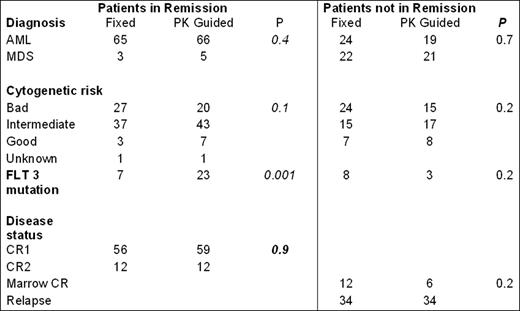Abstract
The myeloablative, reduced toxicity regimen, IV Busulfan (Bu) and fludarabine (Flu), is effective conditioning for allogeneic stem cell transplantation for treatment of patients with AML and MDS. We performed a prospective randomized study to optimize the antileukemic cytoreduction of this regimen, testing the hypothesis that pharmacokinetically (PK-) guided IV Bu-dosing to an average daily AUC of 6,000 μMol-min yields improved leukemia-free survival compared with a fixed IV Bu dose of 130 mg/m2, which gives a median AUC of approximately 5000 μMol-min. The study was approved by the M.D. Anderson Cancer Center IRB and all patients provided informed consent.
The greatest effect was seen in patients not in remission at the time of transplant. The cumulative incidence of disease progression for the PK Guided and Fixed dose groups was 20% and 25% in patients transplanted in remission (P=0.5), and 29% and 50% for patients transplanted not in remission (P=0.03). Major outcomes are summarized in the following table.
In conclusion, administration of higher dose intravenous busulfan using pharmacokinetic dose guidance targeting an AUC of 6000 μMol-min combined with fludarabine improved progression free survival in patients undergoing allogeneic stem cell transplantation for treatment of AML and MDS, without increasing the risks for serious toxicity and treatment-related mortality.
Andersson:Otsuka: Consultancy, MD Anderson Cancer holds a patent on busulfan. Off Label Use: Busulfan for conditioning for AML. Popat:Otsuka: Research Funding. Jones:Otsuka: Membership on an entity's Board of Directors or advisory committees. Nieto:Otsuka Corp: Research Funding. Kebriaei:Otsuka: Research Funding. Worth:Otsuka Corp: Research Funding. Champlin:Otsuka Corp: Research Funding; NCI CA55164: Research Funding.

This icon denotes a clinically relevant abstract
Author notes
Asterisk with author names denotes non-ASH members.




This feature is available to Subscribers Only
Sign In or Create an Account Close Modal